| |
| Medieval font, the
baptistery, Duomo, Verona. |
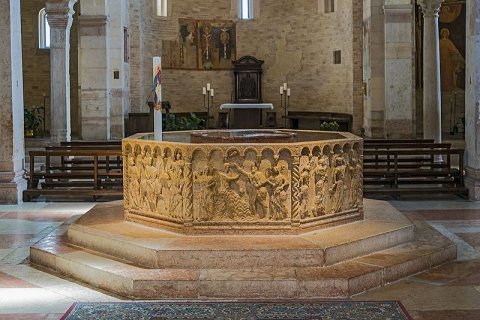 |
This early thirteenth century octagonal font is in the baptistery (San
Giovanni in Fonte) of the Duomo. Attempts have been made to attribute it
to the Veronese sculptor Brioloto, but there seems to be little
agreement on this. There is agreement, though, on the quality of the work
carved from a single piece of marble. It is full of action and even
humour.
As can be seen from the above image, the whole font was not filled with
water; inside the font was a space allowing room for
a priest to stand inside, though it's not entirely clear how he would have
got in there. The eight scenes show the early life of Christ,
from the Annunciation to the Baptism. |
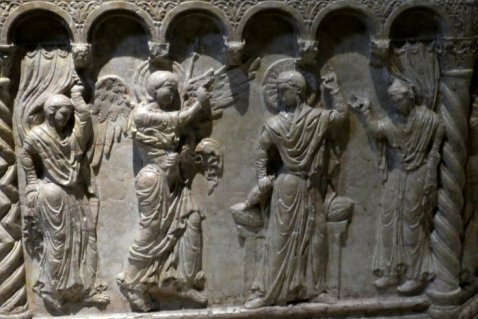 |
 |
The Annunciation and
Nativity. These are
both busy scenes. To judge by the object in the Virgin's hand, she
has been spinning, but see my comments on the 'Flight into Egypt' image
below. The object behind her appears to be a throne-like
chair. The two additional figures are an unusual addition to
an Annunciation; their main function seems to be to draw back the
curtains to reveal the scene.
On the left of the Nativity scene is the Visitation. The Nativity itself
shows the Christ child in that quite convincing manger. Below the
resting Virgin, the midwives Salome and Zeloni prepare to wash the
child. Joseph is shown sleeping, perhaps dreaming of the massacre to come and
the need to flee into Egypt. |
| |
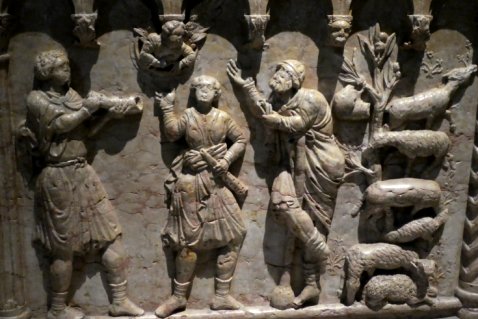 |
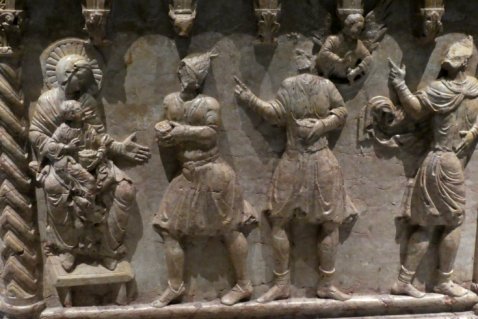 |
The
Annunciation to the Shepherds and the
Adoration of the Magi. The shepherds appear to have been having a musical session as the
angel arrives above. The one on the right appears to have been dancing.
The sheep are stacked up on each other to the right. The tree is
interesting: in its branches are what are said to be a flask of wine and
a bag of flour, eucharistic symbols.
The panel showing the Adoration of the Magi is unusual: the magus on the
right has already handed over his gift, and is on his way out of the
scene. He appears to be in conversation with the angel. |
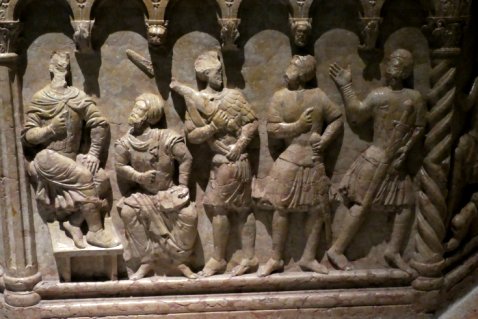 |
Herod orders the Massacre of
the Innocents. This image is an almost exact parallel to the Adoration
of the Magi next to it, with the addition of a seated figure. As with
the adoration scene, the figure on the right is already on his way out,
heading for the massacre scene in the adjacent panel. Note the matching
positions of the feet on the two images.
Now who is the seated figure between Herod and the soldiers? An astute
friend suggests that he is a scribe telling Herod of the text claiming
that Christ will depose him. |
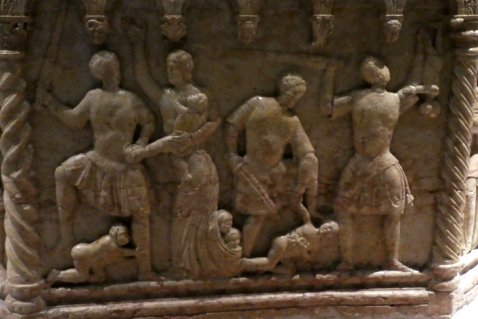 |
 |
| The Massacre of the
Innocents. This is a very moving scene. A mother with young children
hiding in her skirts pleads with a soldier, but to no avail. Another
child hides under the legs of the soldier on the left. The child
in the centre with the agonised face appears to have been disemboweled -
a very graphic image. |
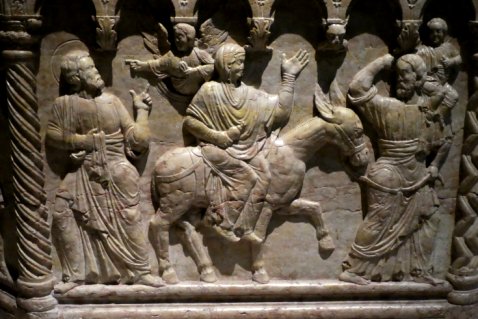 |
 |
The
Flight into Egypt. Joseph appears twice here. On the left, wide awake
this time, he is being warned by an angel. Most unusually, on the right
he is carrying the Christ child in the manner of St Christopher. In
other images he would be with his mother on the donkey.
The Virgin's pose is unusual too. She holds up her left hand, and in her
right hand she carries something that looks quite similar to what she is
holding in the Annunciation image. But what could it be? A weaving
spindle is hardy appropriate here. The Duomo guidebook suggests a
container of water, representative of baptism, and entirely suitable for
a long hot journey to Egypt, but is it? As the following scene is the
Baptism, this is a strong possibility.
Next to her hand is a humorous image of a cat with a rat in its mouth.
The Holy Family have escaped, but the rat hasn't. |
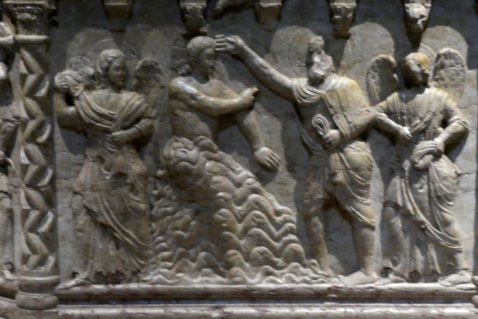 |
|
The Baptism of Christ. Chronologically the final
scene, but, appropriately, it is the scene that faces the entrance to the
baptistery, as shown in the photograph at the top of the page. John holds
another of those mysterious objects in his hand: a water container would be
entirely appropriate here. |
|
|
|
Home page - explore the
site |
